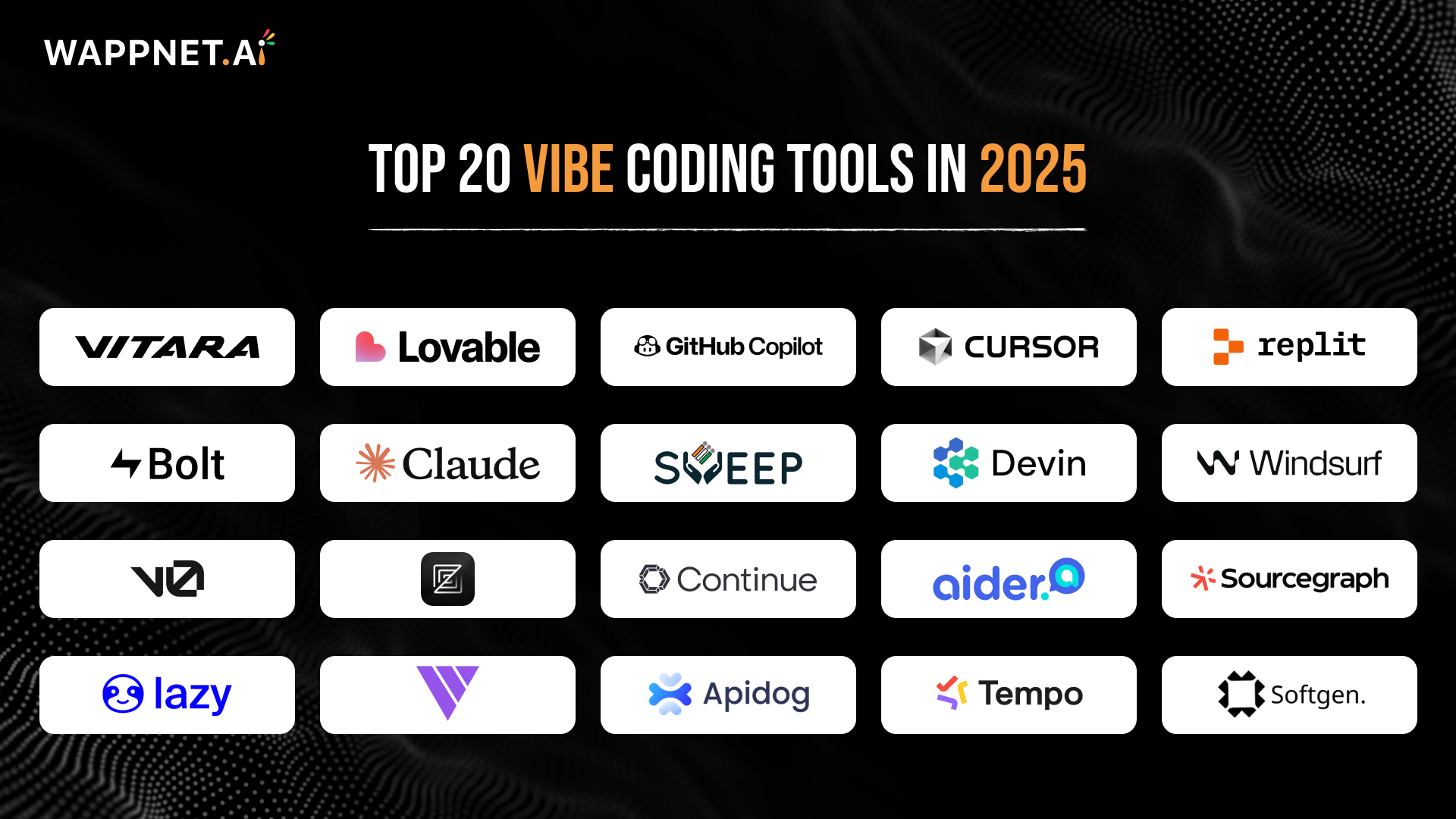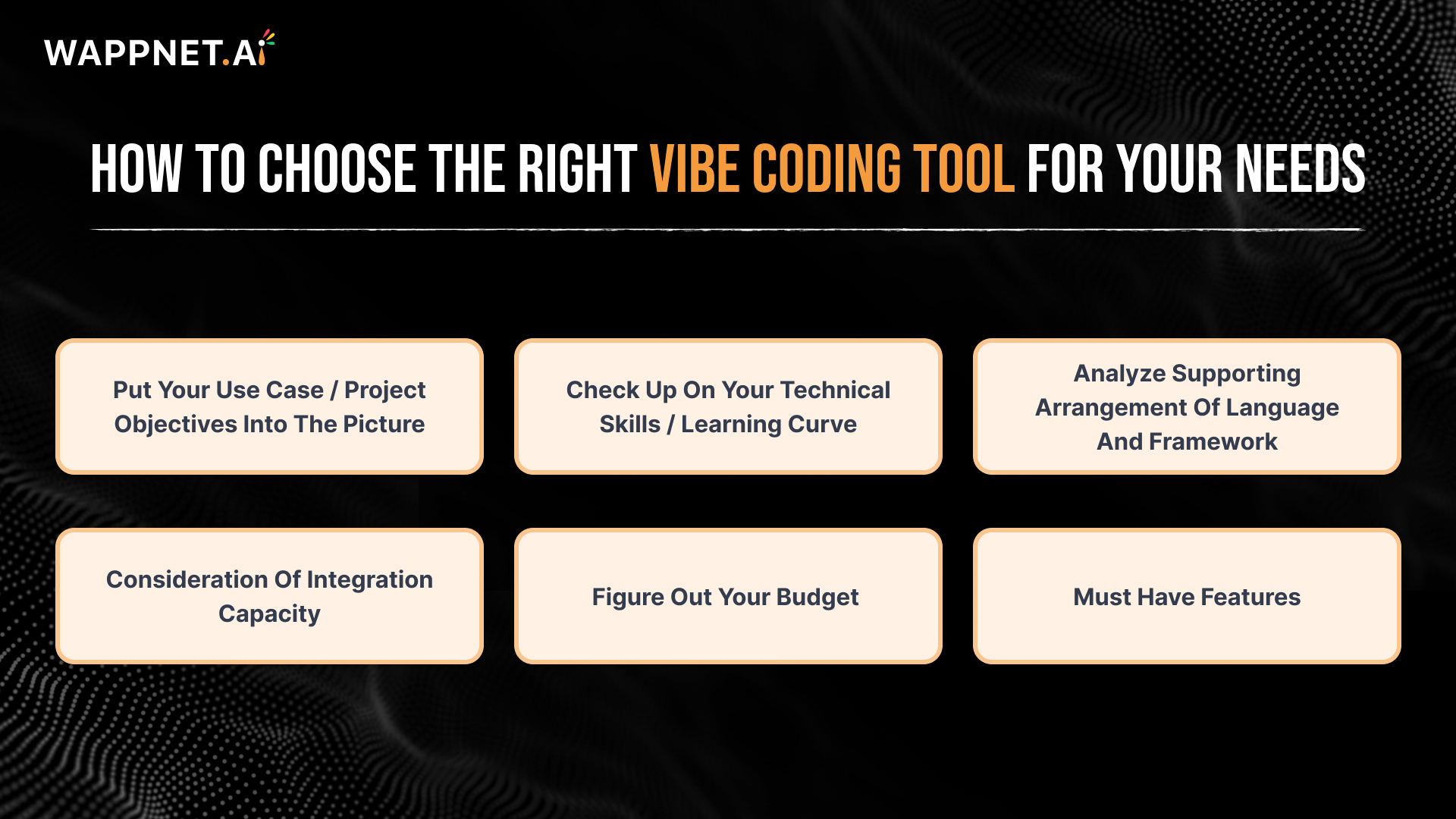In the development world of 2025, vibe coding is the new game in town, and it promises to be fast, fluid, and smart, giving developers more with less. Whether you are an individual developer, a product engineer, or a big team, these tools integrate the three elements of design, code, and collaboration into perfect flows.
This guide presents the Top 20 vibe coding tools transforming code, debugging, collaboration, and deployment. And we will assist you in selection of tools, human place in the new paradigm, and predictions of the future.
Table of Contents
- How We Evaluated the Best Vibe Coding Tools for 2025
- Top 20 Vibe Coding Tools in 2025
- How to Choose the Right Vibe Coding Tool for Your Needs
- What are the Differences?Vibe Coding vs. AI-Assisted Development
- What are the Challenges and Solutions of Implementing Vibe Coding in Software Development?
- What Is the Future of Vibe Coding Tools?
- Conclusion
How We Evaluated the Best Vibe Coding Tools for 2025
We assessed tools based on:
- User experience & interface fluidity
- AI and automation integration
- Multi-language support
- Developer adoption & community
- Workflow enhancement (speed, code quality, etc.)
- Cross-platform compatibility
- Security and privacy considerations
Top 20 Vibe Coding Tools in 2025
1. Vitara
Best For: Designers turning UI into code
You can export Figma or Sketch files and have them converted automatically into responsive React components with Vitara. It has logic mapping and real-time preview built-in, and it is ideal to use by teams that are creating dynamic interfaces or MVPs.
2. Lovable
Best For: Solo founders and indie hackers
Lovable is a vibe-first framework. She says it deals with backend, data config, and frontend generation, all based on natural-language statements. You say what your app is, and it compiles the stack. The in-built AI assistant assists in improving features in a short span.
3. GitHub Copilot
Best For: All developers
With the support of OpenAI, GitHub Copilot is catching on with its domination in the AI code space. By 2025, it is more context-aware, multi-lingual, and cloud-based workflows by all means. It can now write test cases altogether, find anti-patterns as well as propose security solutions.
4. Cursor
Best For: Pair programming with AI
Cursor is a complete coding companion in your IDE. It can interpret your project background, follow logic, and talk of bugs in simple English. Imagine that it is your senior dev helper who keeps everything in mind.
5. Replit
Best For: Browser-based development
Replit is a cloud-based full-stack, real-time environment to code. You can brainstorm, write, and code on the fly with Ghostwriter (its AI assistant). Ideal to create quick prototypes, learn in a classroom, or hackathon.
6. Bolt.new
Best For: Lightning-fast MVPs
Bolt.new is offering a drag-and-drop app builder that offers artificially intelligent generated logic modules. It enables the devs to add APIs, backend logic, and one-click deploy. It is perfect to launch apps within a few hours, but not weeks.
7. Claude
Best For: AI-based code review and refactoring
The Anthropic language model developed by Claude is aligned and safe. It can describe unfamiliar codebases, detect logical errors, and even serve as a documentation engine that runs in real-time within your editor.
8. Sweep
Best For: GitHub workflow automation
Sweep reads your GitHub issues and opens PRs to fix the issues automatically. It is also perfect to use in teams where routine and boilerplate coding are overwhelming or where the level of repetitiveness is too high.
9. Devin by Cognition AI
Best For: End-to-end AI software engineering
Known as the world’s first AI software engineer, Devin is capable of developing applications by entering task prompts. It writes, tests, debugs, and iterates; that is why it is an extremely potent tool to automate the process of software delivery.
10. Windsurf
Best For: Visual developers and fast prototyping
Windsurf brings a whiteboard-to-code flow, where you draw designs, join in logic, and produce actual, working applications. It is the playground to rule of UI/UX design developers.
11. v0 by Vercel
Best For: Frontend teams using Vercel/Next.js
v0 convert all your simple prompts into lovely, designed, editable components. It is highly intertwined with the deployment of Vercel and enables the frontend developer to release faster without compromising code quality.
12. Zed
Best For: Teams that need real-time collaboration
Zed is a multilevel performing code editor. Through instant speed and integrated team code editors, Zed allows individuals to communicate with each other in real time, lag-free, and restriction-free.
13. Continue
Best For: Open-source AI in your IDE
Continue is a free-source coding agent that supports editors such as VS Code. It applies to on-device or cloud-based LLMs to complete code, solve problems, and make tests hosted on your local device while keeping your privacy and freedom.
14. Aider
Best For: Git-based conversational development
Aider is a connection between Git and AI chat. The developer can request Aider to change, fix a bug, or refactor code all in chat and sync changes in the same to the repo..
15. Cody by Sourcegraph
Best For: Working across large codebases
Cody is brilliant in code intelligence. It searches through whole repositories, reads documentation, and makes high-context answers. Perfect to navigate through legacy code, onboard new devs, and automate knowledge finders.
16. Lazy AI
Best For: Non-coders or business users
One may construct a full-stack app using Lazy AI using nothing more than a description of it. It is a logic, data, and API platform that means it is an easy point of entry to product managers or other business teams that just need a fast prototype.
17. Fine.dev
Best For: App builders and template lovers
Fine.dev provides a platform of AI-powered templates and modules that are ready to be deployed. It is perfect in case a startup does not require reinventing the wheel and has to iterate fast with best practices incorporated.
18. Apidog MCP Server
Best For: API-first developers
Apidog allows integrating API architecture, mock testing, as well as server logic, creating a single experience. Its developer-friendly UI and Swagger/OpenAPI integration save the hours of back-and-forth of API workflows.
19. Tempo
Best For: Building internal tools at scale
Tempo enables you to spin up dashboards, approval flows, or databases with drag-and-drop and AI resulting from code generation. It is suitable for operations teams and data-driven startups.
20. Softgen
Best For: Hybrid dev teams
Softgen combines the ease of no-code and the freedom of flexibility with full-code. It is perfectly suited when a team of designers, marketers, and developers has to go together to create actual products, the logic of which is accelerated with the usage of AI.
How to Choose the Right Vibe Coding Tool for Your Needs
Choosing the right vibe coding tool depends on multiple factors:
- Put Your Use Case / Project Objectives into the Picture – Shortly, do you require rapid prototyping, team-based dev, or AI development?
- Check up on Your Technical Skills / Learning Curve – Some tools would guide the inexperienced developers (Replit, Lazy AI), and ones suitable for the more advanced (Zed, Cody).
- Analyze Supporting Arrangement of Language and Framework – Ensure that the tool has your stack- React, Python, Node.js, etc.
- Consideration of Integration Capacity – Verify against GitHub, APIs, CI/CD pipelines, among others.
- Figure out Your Budget – There are free or open-source tools and privileged packages to use in the enterprise.
- Must Have Features – Are you in need of AI completion? Real-time collaboration? Deployment support?
What is the Human Role in Vibe Coding?
Vibe coding is not a matter of changing programmers; it is enhancing them.
Humans provide:
- Intentionality: Leading the vision and the rationality of the code
- Contextual judgment: Business-logical decision-making making Contextual judgment experience, and the current situation.
- Drive: Underlying reason to influence the situation
- Creativity: How to create a better UX and solve abstract tasks
- Quality control: The inspection, glitch-elimination, and optimization of AI products
What are the Differences?Vibe Coding vs. AI-Assisted Development
| Feature | Vibe Coding | Traditional AI Coding |
| Experience | Immersive & fluid | Prompt-based or tool-integrated |
| Workflow | End-to-end coding flow | Mainly autocomplete / code generation |
| Collaboration | Often real-time | Mostly solo |
| Output | UI + Logic + Deployment | Code snippets or components |
| Interaction | Chat, GUI, code | Mostly text/code-based |
Read More: LLM Benchmarks: The Key to Smarter and More Efficient AI Models
What are the Challenges and Solutions of Implementing Vibe Coding in Software Development?
1. The Quality of Code Does Not Always Remain Consistent
Solution: Employ tools that have high testing, documentation, and version control capacities.
2. It can be difficult to debug AI-generated code
Solution: Match with code intelligence systems such as Cody or Claude to know more.
3. Artificial Intelligence is Confused by Complex or Novel Tasks
Solution: Take vibe coding tools as the beginning point-refactor and validate manually.
4. Security Risks Exist
Solution: Resort to AI tools that will focus on secure coding principles and codebase scan.
What Is the Future of Vibe Coding Tools?
1. Greater inclusion into the Dev Stack
All this should be a part of a single continuous interface, including IDEs, CI/CD, testing, and deployment.
2. Multi-Agent Collaboration
AI agents cooperating to debug and test, and even in designing your features.
3. Domain-Specific Intelligence
plugins and intelligence come in industry-specific coding templates, including in healthcare, fintech, gaming, etc.
4. Greater Natural Interactions
Whiteboard-to-code interface, voice-to-code interface, and gesture control will go mainstream.
5. Responsible AI Becomes a Priority
Privacy-first systems, explainable AI, and open-source audits will drive them.
Conclusion
The future of 2025 in the world of vibe coding is not only concerned with writing code, but it also involves making it wittier, faster, and more enjoyable. These 20 tools display the process of coding transforming into a team effort, creative, and AI-augmented adventure.
Whether you are doing it as a side project, growing enterprise applications, or just experimenting to see what you could do, this is the best time to reshape your tool set and bring your coding to the next level.
Gesture control, voice-to-code, and whiteboard-to-code interfaces will become mainstream.


